I wrote a quick python script to return the average colour of rectangles surrounding the perimeter of my screen. (The end goal here is to have RGB LED strips surrounding my monitor, for a glowing effect during movies - like this (youtube), but more fun because I'm making it myself).
I'm currently using autopy for getting the screen as a bitmap ("screenshot"), getting each pixel value, and the RGB <-> HEX conversions.
Simplified version:
step = 1
width = 5
height = 5
b = autopy.bitmap.capture_screen()
for block in border_block(width, height): # for each rectangle around the perimeter of my screen
R,G,B = 0,0,0
count = 0
for x in xrange(block.x_min, block.x_max, step):
for y in xrange(block.y_min, block.y_max, step):
r,g,b = autopy.color.hex_to_rgb(image.get_color(x, y))
R += r; G += g; B += b
count += 1
block.colour = "#{:06x}".format(autopy.color.rgb_to_hex(R/count,G/count,B/count))
I then display the blocks using matplotlib: (this is configured as 5x5 blocks, step = 1)

The problem is the speed of implementation - because this is looping for each pixel in a block (2560*1600 resolution/5 = 320*512 block = 163,840 pixels per block), and each block around the perimeter (16*163,840 = 2,621,440 loops). Overall, this took took 2.814s to complete.
If I increase the step value, it speeds up, but not enough: (this is using a more realistic 15x10 blocks surrounding the border)
Step Time (s)
1 1.35099983215
2 0.431000232697
5 0.137000083923
10 0.0980000495911
15 0.095999956131
20 0.0839998722076
50 0.0759999752045
That's because the screenshot itself takes approx 0.070s - this means that I'm limited to 12.8 FPS.
>>> timeit.Timer("autopy.bitmap.capture_screen()", "import autopy").timeit(100)/100
0.06874468830306966
Questions:
Is there a faster method of taking a screenshot and averaging regions of the screen?
I'm not too worried about accuracy, but would like to be able to return these values at approx 30 FPS, ideally faster (20-30 ms) to allow for serial transmission overhead. Bear in mind my screen resolution is 2560*1600!
I've heard about Python Imaging Library (PIL), but haven't had time to look into the speed of the
ImageGrabfunction yet, but it looks promising.Can I read pixel values directly from the GPU?
Another thought - what's the best way to detect the top/bottom edge of a movie? (If aspect ratio is widescreen, there are black bars at top/bottom of screenshot, and some rectangles are black).
Using PIL's grab():
>>> timeit.Timer("ImageGrab.grab()", "from PIL import ImageGrab").timeit(100)/100
0.1099840205312789
PIL - resize: (ChristopheD)
>>> timeit.Timer("PIL.ImageGrab.grab().resize((15, 10), PIL.Image.NEAREST)", "import PIL").timeit(100)/100
0.1028043677442085
>>> timeit.Timer("PIL.ImageGrab.grab().resize((15, 10), PIL.Image.ANTIALIAS)", "import PIL").timeit(100)/100
0.3267692217886088
Note: This is an improvement over the results obtained above, but we're still limited to 9 FPS, or 3 FPS with full anti-aliasing.
PIL - nearest then resize: (Mark Ransom)
>>> for step in [1,2,5,10,15,20,50]:
print step, timeit.Timer("PIL.ImageGrab.grab().resize(("+str(2560/step)+", "+str(1600/step)+"), PIL.Image.NEAREST).resize((15, 10), PIL.Image.ANTIALIAS)", "import PIL.ImageGrab").timeit(100)/100
Results:
Step Time(s)
1 0.333048412226
2 0.16206895716
5 0.117172371393
10 0.102383282629
15 0.101844097599
20 0.101229094581
50 0.100824552193
Much faster than manually looping with autopy at top, but we're still limited to ~9 FPS (at a 'step' of 10).
Note: This doesn't include the RGB to HEX conversion required
Can anyone come up with a faster method - i.e. taking a partial screenshot? Should I write something in C?